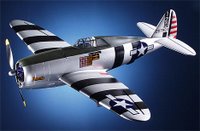
Electric engines are mostly used in RTF's and beginner planes. Just as glow plug engines they vary in size, weight, power and price.
Learn about the remote controlled plane models and how to fly them!
 Like I wrote earlier, glow plug engines are used in RC plane toys. There are basically two kinds of glow plug engines, 2-stroke and 4-stroke. The difference is that the 2-stroke engine fires once per revolution while the 4-stroke fires once every two revolutions. They also vary in displacement and other characteristics. The displacement is expressed in cubic inches (cu in) or cubic centimeter (cc), and can be from 0.4cu in (6.5cc) all the way to 1.4cu in (23 cc). The output power varies from 1 to 4 BHP. The prices go from 50-60 dollars upward.
Like I wrote earlier, glow plug engines are used in RC plane toys. There are basically two kinds of glow plug engines, 2-stroke and 4-stroke. The difference is that the 2-stroke engine fires once per revolution while the 4-stroke fires once every two revolutions. They also vary in displacement and other characteristics. The displacement is expressed in cubic inches (cu in) or cubic centimeter (cc), and can be from 0.4cu in (6.5cc) all the way to 1.4cu in (23 cc). The output power varies from 1 to 4 BHP. The prices go from 50-60 dollars upward.
 This is another group of airplane models. They're basically the same as all the other plane toys, except they have two engines. The engines can also be electric or glow plug. In some cases if you need more power you can install two-cylinder glow plug engine instead of two single cylinder engines. I'll give you an example. If you already have a RC model and you decide you need more power or you just want it to fly faster, it's easier to replace your current engine than to add one more. The problem would be where to put it? You would have to make some modifications to the fuselage, which in consequence can mess up the plane model if you don't have some experience. Installing two-cylinder engine also requires some modifications, due to weight increase in the nose of the plane models. The point is, if you are not experienced hobbyist, don't do it. If you want two engine RC model, buy it as RTF (ready to fly) and enjoy!!
This is another group of airplane models. They're basically the same as all the other plane toys, except they have two engines. The engines can also be electric or glow plug. In some cases if you need more power you can install two-cylinder glow plug engine instead of two single cylinder engines. I'll give you an example. If you already have a RC model and you decide you need more power or you just want it to fly faster, it's easier to replace your current engine than to add one more. The problem would be where to put it? You would have to make some modifications to the fuselage, which in consequence can mess up the plane model if you don't have some experience. Installing two-cylinder engine also requires some modifications, due to weight increase in the nose of the plane models. The point is, if you are not experienced hobbyist, don't do it. If you want two engine RC model, buy it as RTF (ready to fly) and enjoy!!






